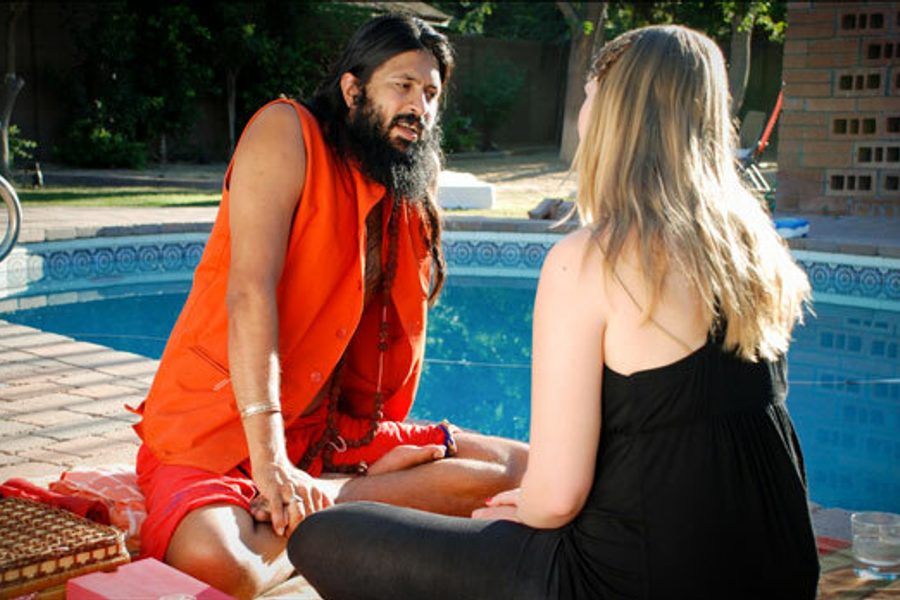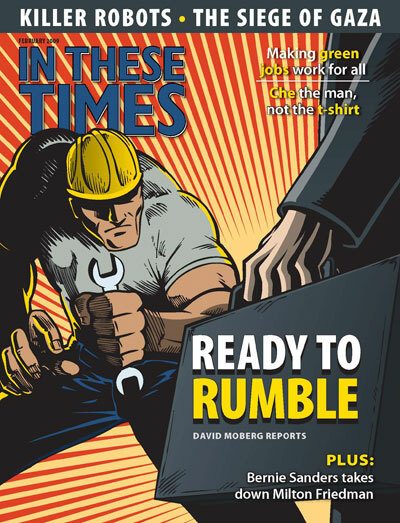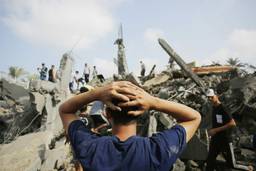A Massacre in 3/4 Time
Waltz with Bashir is hallucinatory, relentless, and amazing.
Michael Atkinson

Arguably the most unique film to come out of any global corner in 2008, filmmaker Ari Folman’s Waltz with Bashir can be defined, just on its surface, as a head-shaking fugue between social documentary and digitally animated epic.
But as you’d expect, given the inherent contradictions, it is significantly more: It’s Israeli, for one thing, and it’s a direct cinematic address of the 1982 massacre of Palestinian civilians in the West Beirut refugee camps of Sabra and Shatila, for another.
And can a documentary be animated? The moment you create a film frame by frame, out of the stressed cloth of memory, how close could it be to the truth?
“Which truth?” Folman would surely ask right back, and Waltz with Bashir brilliantly echoes its cultural investigations with its formal contradictions.
The aspect of the film that hits you first, in the eyeballs, is its visual torque. From the opening, of a pack of ravenous, fanged dogs running through the Tel Aviv streets under a stormy yellow sky – drawn and animated with high-contrast, nightmarish surreality – it becomes clear that Bashir looks and feels unlike any other film. It is difficult to pin down exactly how the film – which began its U.S. run on Christmas Day – was manufactured, and the disarming, solitary visual tide of it is enough to brand it upon your brain. For a subjective portrait of the lysergic experience of war, it’s relentlessly amazing.
The dogs are part of a dream – the dream of an Israeli soldier who, during the 1982 invasion of Lebanon, couldn’t shoot people, so he was given the thankless task of shooting watchdogs, all 26 of which hunt him in his dreams. The soldier is just one compatriot sought out by Folman, who, 25 years after serving in the Israeli army and being present for the ‘82 massacre, cannot remember a thing about it.
So he interviewed friends from that time, and friends of friends, to find out what happened and, by extension, why he has suppressed the memories. The interviews became the fulcrum of the feature, as animated versions of very real people speak with an animated Folman about the invasion and about the heady days of Israeli empowerment under former Prime Minister Menachem Begin.
Most of Folman’s film visualizes those reminiscences, vividly captured in a dazzling, almost exhausting cataract of visual invention. The tableaux – entire landscapes scorched by bombings, a downed pilot’s lost-at-sea hallucination of a giant naked woman, an international airport wrecked and abandoned after an aerial attack, a lingering stream of blood running from the back door of an armored vehicle – could hardly have been rendered so energetically, or indeed rendered at all, in a modestly budgeted live-action film. Points of view are always shifting, time frames meld, what the soldiers think they saw supplants the reality.
Manners of seeing – and of interpretation – are at the heart of the movie’s many recurring metaphors. Folman’s own repeated dream image (one of the few that persist) is of fiery lights falling softly from the night sky. Various characters remember the lights as rocket fire and a meteor shower, but only later do we (and Folman’s avatar) understand what they are: flares the Israeli soldiers shot to illuminate the sky above the Sabra and Shatila refugee camps, passively allowing the Lebanese members of the right-wing Phalange Party to carry out their bloody work.
Given a little thought, profound Israeli guilt seeps out of the film’s title. The history behind it plays like an escalation paradigm: Less than a month after Israel had invaded Lebanon in 1982 to assault Palestine Liberation Organization (PLO) strongholds, Syrian operatives assassinated the newly and narrowly elected Christian militia leader (and Israel glad-hander) Bashir Gemayel. As retribution, two days later, Gemayel’s Phalangist militias, with the cooperation of the occupying Israelis, slaughtered 2,000 Palestinian refugees – an act that dwarfed the PLO’s car bombings in every way and drew international scorn. Like a waltz partner, the Israeli army (all young, naive conscripts) was close but did not touch, leading but otherwise merely following the music and the proscribed dance steps.
After too many recent Israeli films (including quite a few good ones) that waffle about the Israeli-Palestinian question, and that too often adopt a Crash-like, can’t-we-just-get-along centrism, it’s exhilarating to see a politically aware film in full attack mode, using disorienting cinematic tools but emerging as an unfettered critique of militarism.
As Stuart Klawans recently pointed out in Film Comment magazine, it may seem disproportionate to hang the film on the retrospective angst of Jewish soldiers and not on the massacre victims themselves. But Folman’s film is much more of an interrogation than a plea for sympathy. (In fact, I suspect that Folman didn’t actually forget all that much, and invented his own forgetfulness to abet the film’s structure.)
In any case, the climactic passage reverts to stock footage of the dead refugees – including children’s body parts jutting out of rubble, exactly as discussed by the animated characters earlier – and our questions, about where our empathy is supposed to land, simply dry up and blow away.
It may not, in the end, be a documentary at all, but as revelatory a social document as Middle Eastern cinema has ever produced. It certainly could not have arrived at a more pungent moment, as Gaza explodes and Palestinian civilians again face monstrous reprisals.









